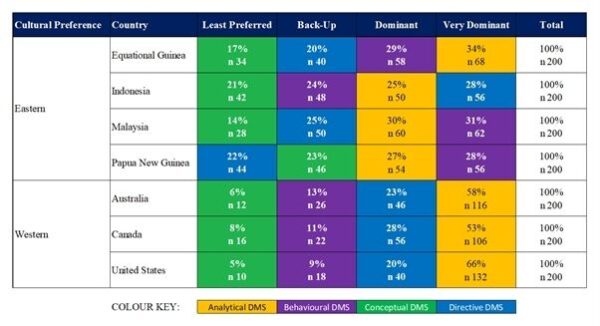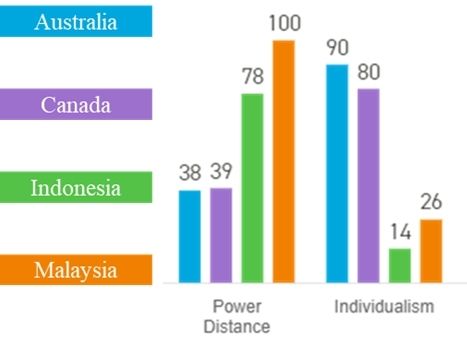Leading global teams can create a number of challenges in communication, expectations, and cultural norms. This article discusses research from Ingenium into how does decision-making style differ between East and West and what are the behaviours required when engaging with teams worldwide?
What is DMS?
The participant data represented in this article represents all StyleUs™ DMS, split into the four main styles, Analytical, Behavioural, Conceptual, and Directive. The objective is to look at transactional & transformational capacity across all styles while accepting that all four styles are vitally important and necessary to a balanced decision-making process.
In this article, the U.S., Canada, and Australia are considered Western cultures. Eastern Culture’s examined in comparison are Malaysia, Indonesia, Equatorial Guinea, and Papa New Guinea.
Transactional Vs Transformational Decision Making
‘Transactional’ decision-making traits were linked with analytical & directive styles, and ‘Transformational’ decision-making traits were associated with the conceptual & behavioral styles.
How is DMS calculated?
The StyleUs™ DMS data is profiled for different levels of styles from > 10% to > 27% across all four styles. The thresholds of >20% in any one or combination of styles demonstrate agility within the decision-makers sphere to comfortably adapt to the situation’s required style.
Decision-Making Style across cultures:

Figure 1.1.1 outlines the decision-making styles seen across the seven locations, grouped by cultural preference across the four-color coded decision-making styles. Participants from the U.S., Canada, and Australia all ranked highest in Analytical DMS. In comparison, Equatorial Guinea represented the highest ‘very dominant’ level within eastern cultures in this study with just 34% having a ‘very dominant directive DMS’.
All three western culture countries had a significant ‘dominant’ Directive DMS level, 23%, 28%, and 20%, respectively. This points to a very ‘Transactional’ decision-making trait linked to these three countries. The individualist trait is further backed up from the data outlined in figure 1.1.2, supplied by Hofstede’s Cultural Survey (2020), which creates national cultural profiles. Compiling the data from these two data sources, most participants in Western cultural countries preferred an Analytical DMS compared to Behavioural, Conceptual, and Directive with less agility to move around the decision-making styles with ease.
DMS in Eastern Cultures
The data shows significantly less dispersion in results across the four decision-making styles from an eastern cultural perspective. Equational Guinea, Malaysia, Indonesia, and PNG all have a tighter dispersion between their ‘Very Dominant’ and ‘Least Preferred’ levels when compared to the effective dispersion rates seen in Australia, Canada, and the United States.
The superior DMS
This dispersion tolerance is essential as Rowe and Boulgarides (1992) emphasized two primary concerns when calculating, evaluating, and drawing conclusions from decision-making styles. The concern relates to an individual decision style and the ability of an individual to be adaptable. There is a need to ask if there is one best decision-making style and, how flexible can a person’s decision-making style really be?
Rowe and Boulgarides emphasized that no one decision-making style is more effective than any other; a combination of all four styles is dependent on the situation one finds themselves in at that moment in time.
Eastern Flexibility
With regards to adaptability, based on the findings from StyleUs™ DMS dispersion rates and considering Rowe and Boulgarides’ model, it can be assumed that a significant majority of eastern culture countries would find it easier to be flexible. Eastern cultures have a better ability to move between the decision-making styles based on the situation; whereas western cultures are more focused on their ‘individual’ ways and may find it harder to express the required flexibility.
Moving from East to West
The willingness to be open and engage is essential should leadership teams from western cultures move into eastern culture countries. The ability to communicate in a clear, succinct manner is critical as, these cultures display ‘very dominant’ and ‘dominant levels of behavioral DMS, the instructions will be taken on the literal meaning and implemented as so.
Hofstede’s Cultural Survey Assessment
To add further validity to the data above, Hofstede’s Culture Compass™ (2020) provides a national cultural perspective to compare with the StyleUs™ DMS findings. Figure 2.1.2 shows the difference between Australia and Canada from western culture and Indonesia and Malaysia from eastern cultures across power distance and individualism.
*When writing this, the cultural data for Equatorial Guinea and PNG was not available from Hofstede.

This research shows the ‘Transactional’ decision-making traits of the western cultures, where there is a greater importance placed on one’s identity (individualism); the comfort at which the views of leaders can be challenged (power distance); decision-making is done hastily, valuing speed over due diligence and from a business perspective, moving quickly to the topic in question and delivering on the project objectives and schedule.
Compared to this, the ‘Transformational’ decision-making traits linked with eastern cultures place far greater importance on social acceptance, relationship building and establishing processes and procedural norms.
If you are interested in learning more about Decision Making Styles, Cultures and how this can help you and your organisation make safer decisions, enroll in our Online Safe Choice starting on October 27th.